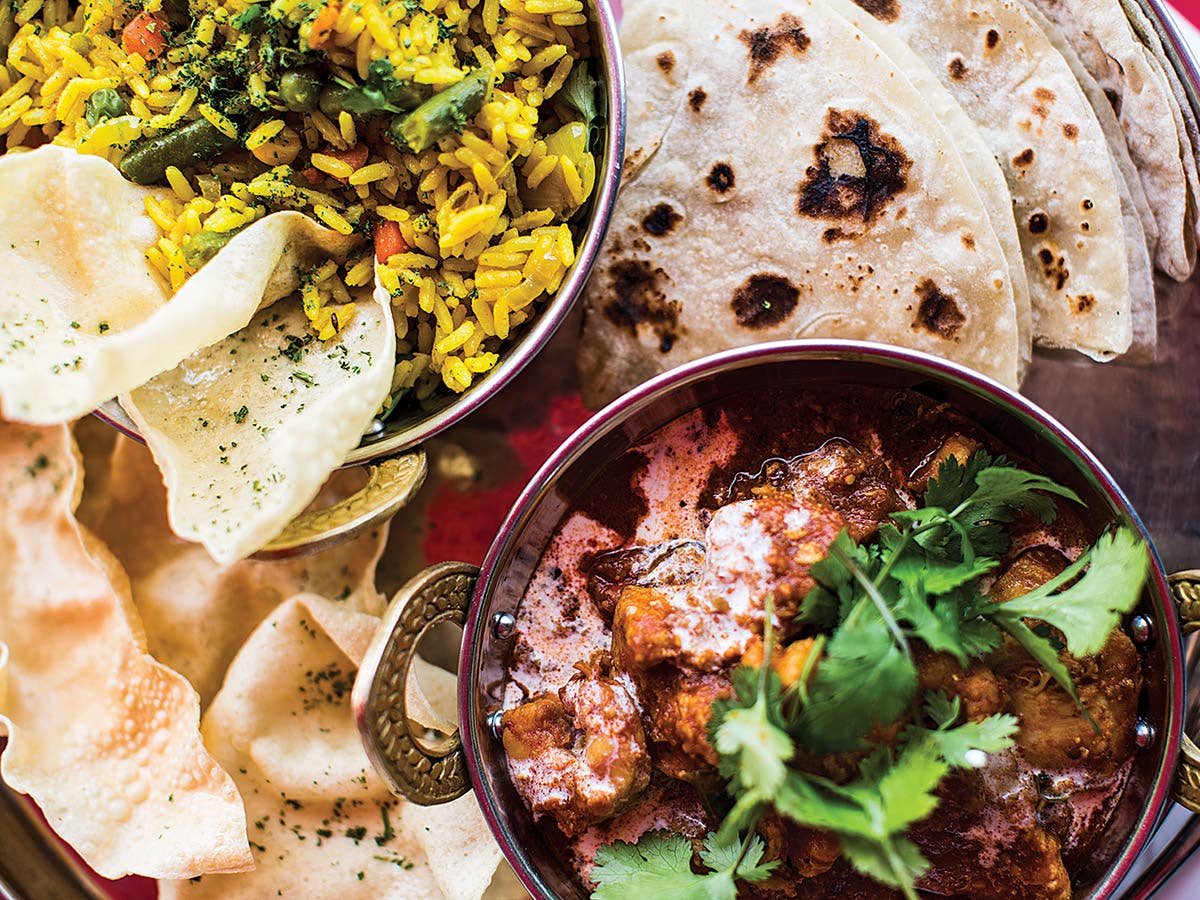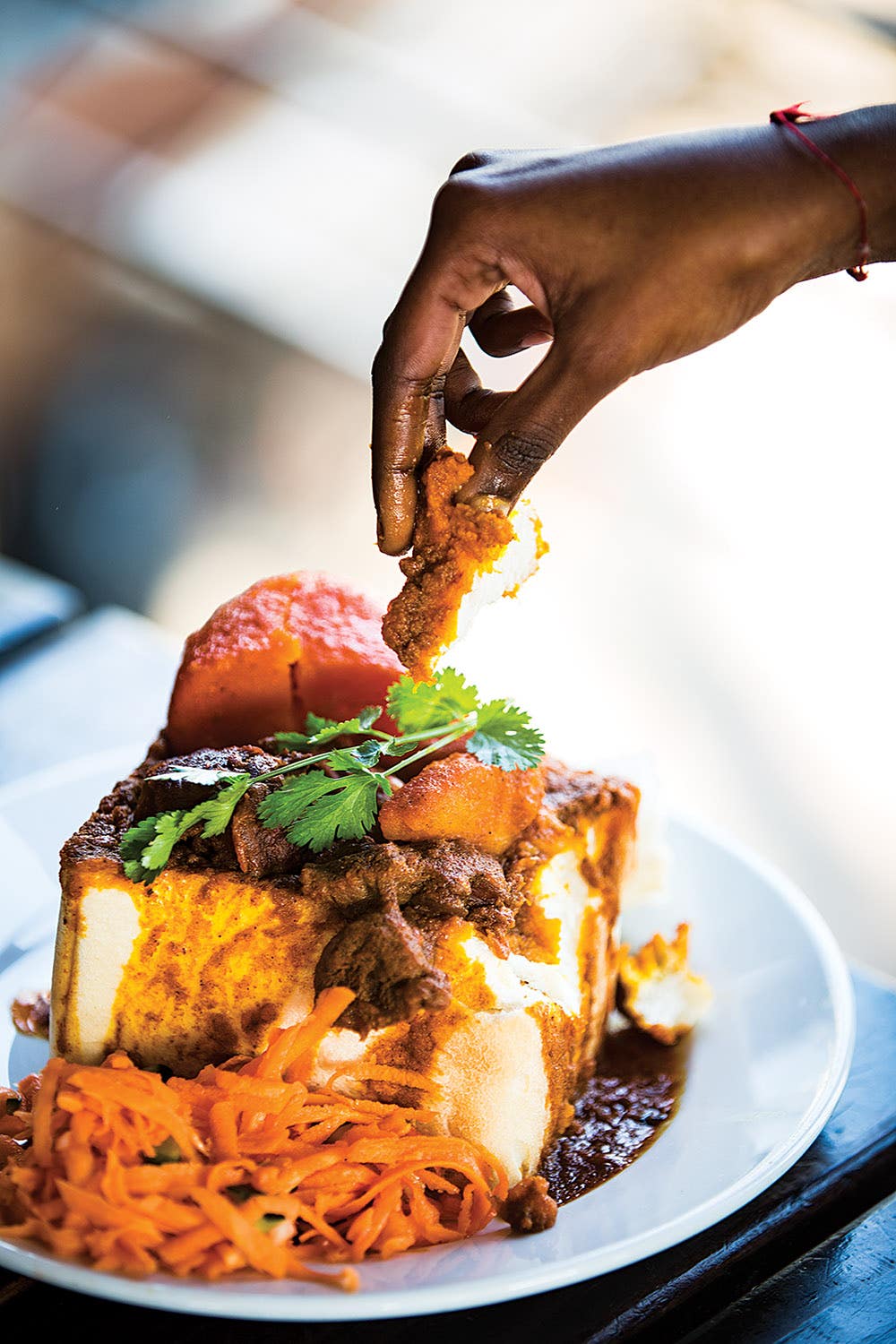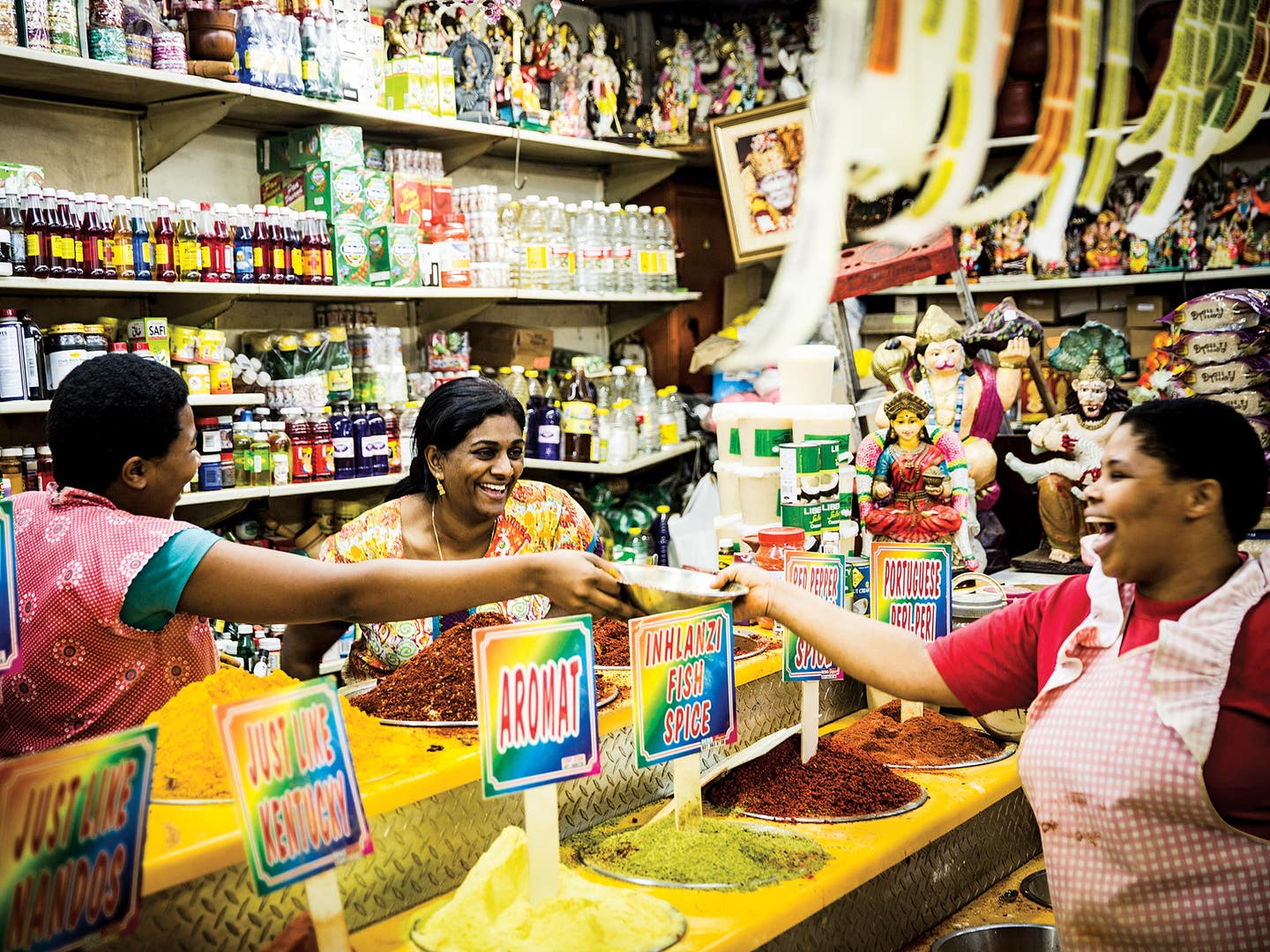
Eating Bunny Chow in Durban
Shaped by apartheid and a massive but isolated Indian population, the food of this South African city stands apart
It's a sunny winter Thursday, just past noon, and on the streets of Durban, bakkies (pickup trucks) idle double- and triple-parked across wide boulevards as workers heave deliveries in and out of nearby shops. Ears of corn lap up flames on outdoor grills; women get their braids coiled by the side of the road. The heart of the city's Central Business District hums with a scene that plays out daily, with the most minor of variations, across Africa in Kinshasa, Dakar, Bulawayo, and Gaborone.
And yet, the action here unfolds in the shadow of the sprawling Juma Mosque, seemingly plucked from the by-lanes of Delhi, the sun glinting nimbly off its golden domes. Streets named Dr. Yusuf Dadoo and J. N. Singh intersect with Bertha Mkhize and Dorothy Nyembe. Bollywood melodies waft down the street, colliding with pulsating Afropop tracks. A man slaps messy mounds of curry and rice onto flimsy paper plates at a roadside soup kitchen. Businesses like Punjabi Flair and Raja Jee Traders share walls and patrons with shisa nyama, or grill houses. In the century-old Victoria Street Market, among shops hawking embellished ostrich eggs and vuvuzelas, there is R. A. Moodley, selling gaudy dunes of breyani masala to a predominantly black clientele. And across the city, no-frills curry houses are snarled with brisk lunchtime business, serving spicy curries in bread bowls, a dish called bunny chow, by the hundreds. An unmistakable Indian accent is what sets Durban apart.
Thanks to massive waves of migration from India in the mid 19th century—first came the indentured laborers in the 1860s, followed soon after by an opportunistic merchant class who opened businesses catering to this growing community—Durban is now home to one of the largest populations of Indian descent anywhere in the world. But the layered symbiosis of geography, politics, poverty, and the inevitable passage of time means that many South African Indians share little in common beyond appearance with their subcontinental cousins.
I suppose I'd be considered one of those long-lost relatives, a first-generation Indian-American with strong ties to my parents' birthplace of Hyderabad. At first glance, the Indian culture I encountered in South Africa struck me as reassuringly familiar. But after living in Cape Town for three years, the differences became more and more evident: The flavors, the morphed traditions, and even the evolved spellings of common Indian surnames and vocabulary, with Qasim and Qazi recast as Cassim and Kajee, all register to me, an expat who considers India my second home, as pleasingly, disorientingly, foreign.
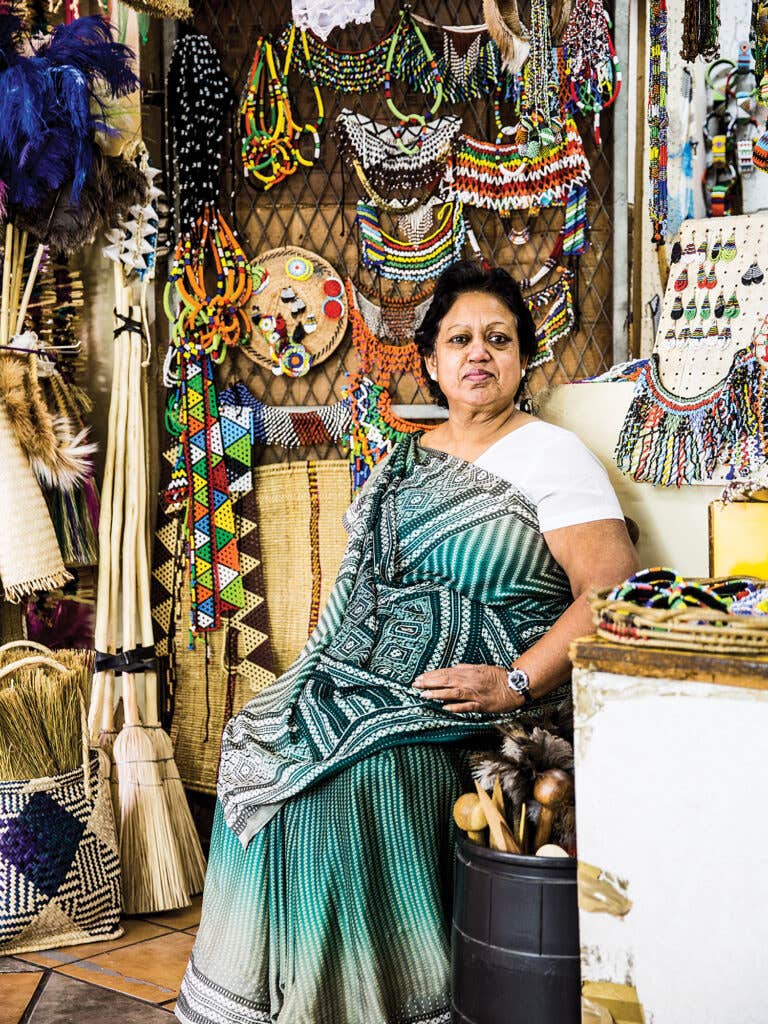
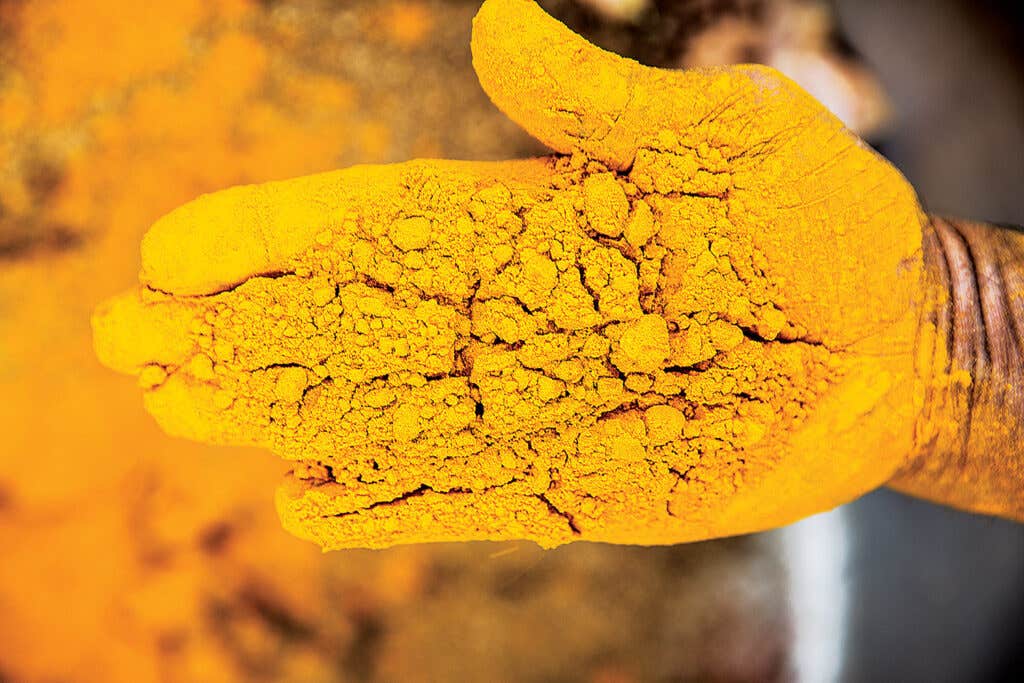
“Indian cuisine here in South Africa is totally different from India,” says Raj Govender, chief director of the KwaZulu-Natal province's Department of Arts and Culture. When Indians began arriving in Durban from Kerala, Tamil Nadu, Andhra Pradesh, Gujarat, and Karnataka in small numbers, traditions and flavors that never had occasion to interact back home began coalescing on faraway shores. “We found commonalities in some cultural practices and cuisine, and discarded some others,” Govender says.
That pan-Indian influence, combined with the scarcity of familiar spices and ingredients, drove cooks to innovate with readily available produce and regional traditions, and culminated in the development of a new dialect of Indian cookery. Out went the dairy, coconut milk, and hard-to-source spices like saffron; in came amadumbe (taro), calabash (gourd), mielie-meal (maize flour), semp (dried corn kernels), and pumpkin. Lentils found their way into the folds of biryani, which over time became known locally as breyani. Samosas have mutated into samoosas in Durban, though they're often trumped in both taste and popularity by European-inspired pies stuffed with masala steak or chicken.
“Before apartheid, Indians and blacks lived very closely—Indians could speak Zulu, blacks understood Gujarati. And so the food became very mixed, with curries adopting African flavor,” Govender says. “Our practices are not like India. It's evolved into a South African Indian identity.”
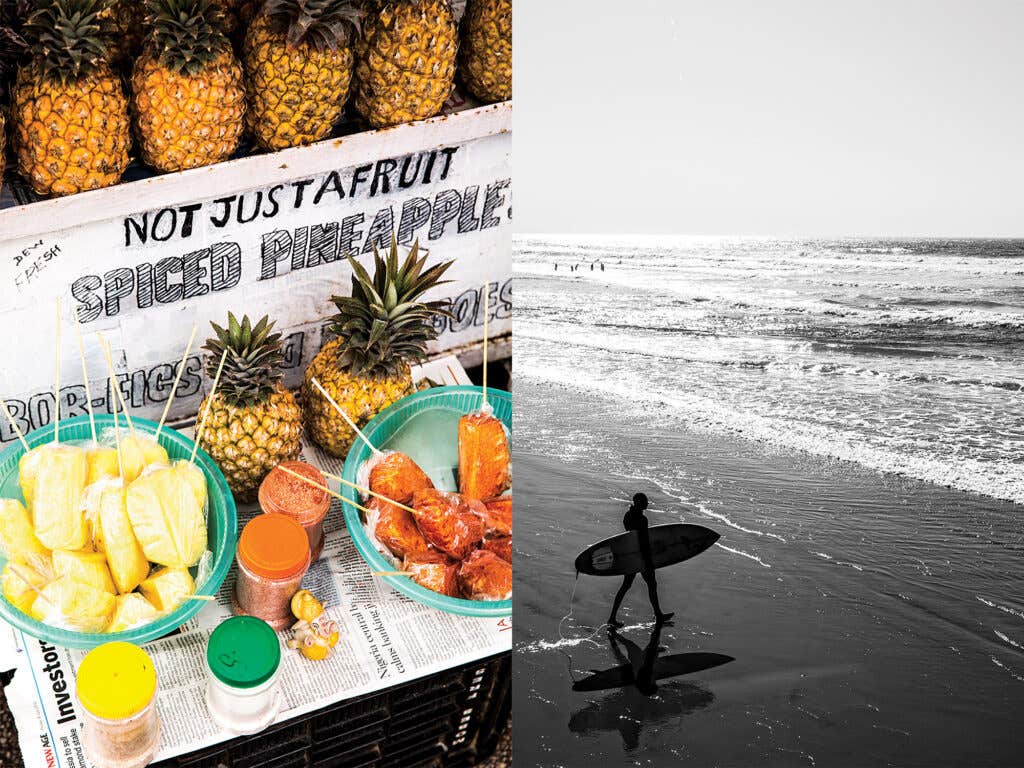
No dish is more representative of the South African Indian experience than bunny chow, a Durban street-food classic with an origin story as intriguing as its name. The brutal divide-and-conquer policies of South Africa' apartheid era succeeded in breaking down much of the harmony between races. "Apartheid destroyed the zest to learn other cultural practices," Govender laments. But it also led to unexpected culinary creativity born strictly out of necessity. No longer able to serve black workers who made up a sizable client base, restaurateurs from the Gujarati bania, or merchant caste, began innovating. They cleaved loaves of white bread into improvised bowls, filled them to the brim with whatever curries they had on hand, and served this portable (if messy) concoction surreptitiously out of takeaway hatches, with nary a parcel or piece of cutlery to betray their lucrative side business. Food of the banias: bunny chow. A national obsession was born.
Patel's Vegetarian Refreshment Room is a dingy hole-in-the-wall on Dr. Yusuf Dadoo Street with patrons ranging from hipsters to hijabis, black laborers to tourists. Patel's, a family business dating to the 1930s, claims to have invented the bunny chow; other reputable sources credit the erstwhile Kapitan's café. No matter who invented the sloppy classic, may he rest in peace, these days there are an abundance of takes to choose from. Patel's is where you head for strictly vegetarian offerings filled with sugar beans, broad beans, moong dal, or mixed vegetables. Nearby Victory Lounge has ardent groupies swearing by its mutton version; in a nondescript shopping mall, Oriental earns the dubious honor of the bunny most likely to incinerate your palate; and perhaps the most unlikely contender, the garishly purple-tinted Hollywood Bets, is a gambling hall with a beloved menu, crammed from 7 a.m. till late with people devouring curried mutton sandwiches, chicken roti wraps, sweet corn and cheese samoosas and, of course, mutton, chicken, and sugar bean bunnies paired with chile vinegars and sambal condiments. The horse races they watch on TV may not always work out in their favor, but patrons know they're guaranteed a sure thing with one of the city's best bunnies.
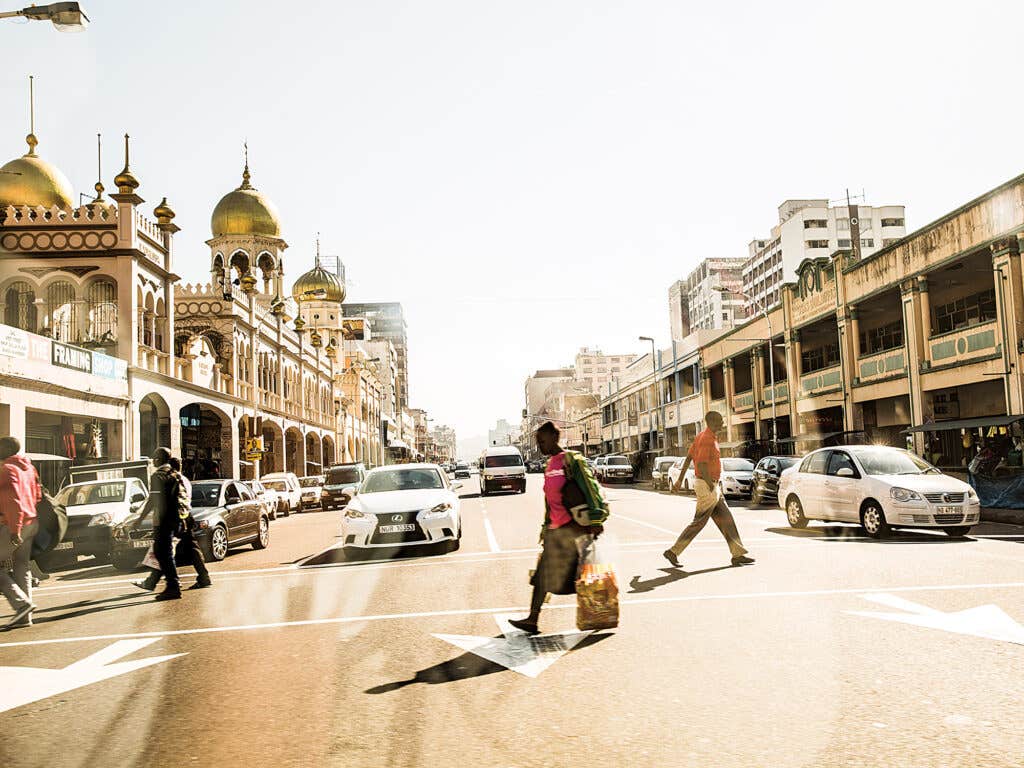
About 20 minutes away from the gritty environs of the CBD is the posh seaside enclave of Umhlanga. There, the elegant pile that is the Oyster Box Hotel presides over a prime stretch of beachfront overlooking a red-and-white lighthouse. The Oyster Box evokes old-world glamour with colonial touches: turbaned doormen, genteel gardens, ceiling fans spinning lazily above a lavish high-tea spread. It's also home to a lauded daily curry buffet, the pet project of head chef Luke Nair, who oversees the 11 curries and assorted carbs and condiments that accompany them. Nair is a Durban native with more than 40 years' experience in kitchens across the city and has cooked his fiery hometown fare for the likes of Margaret Thatcher, Al Gore, and the Queen of England herself.
I watch as he expertly upturns 100 pounds of lamb in a bathtub-size tilting pan for the day's lunch service: a gallon of oil, three pounds of ginger-garlic paste, 15 heaping ladles of scarlet Durban-style curry powder, entire frying pans full of diced tomatoes chucked into the simmering vat by instinct, not measurement. In between, he barks out instructions to his staff in Zulu and teases his Pakistani pastry chef. “They love me,” he tells me with a wink.
“I'm South African, born and brought up. I think my granny was from India,” he says, not entirely certain. “Honestly, I don't really like Indian food in India—I just have a sandwich there. Our cooking is spicier than theirs.”
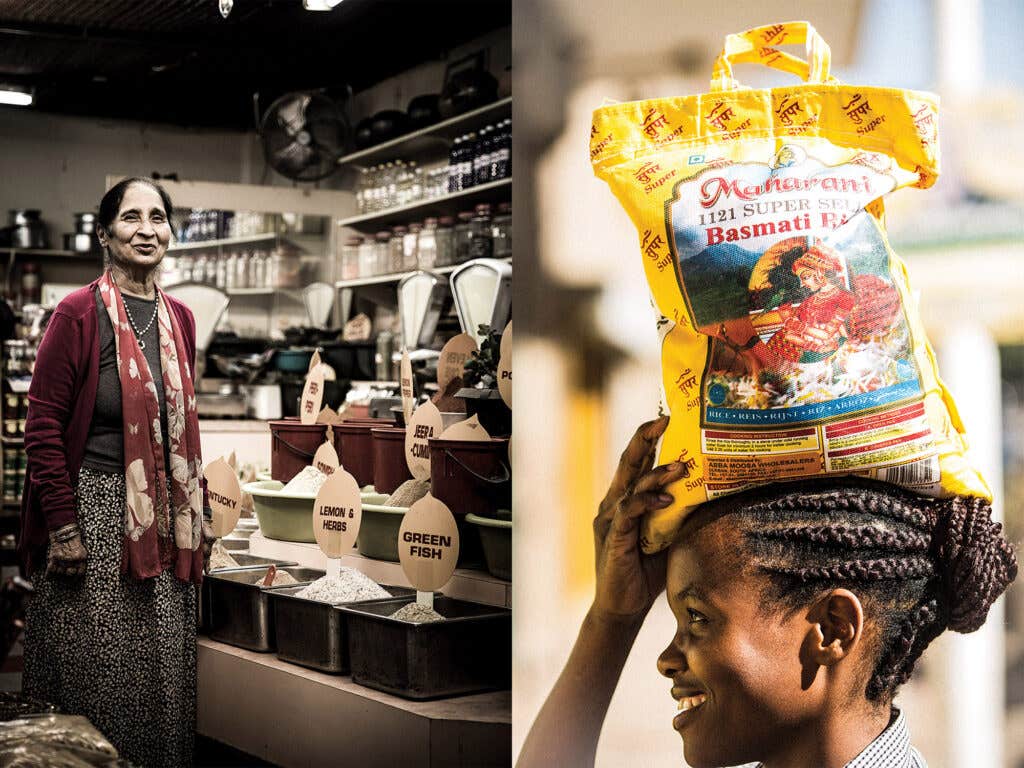
To understand what makes Durban's curry-powder progeny so distinct from their ancestors, I head back to the CBD, where the cavernous Spice Emporium has for decades been plying city residents with all their Indian essentials: incense and steel pots, chai and cookbooks, a whole aisle devoted to a rainbow of lentils, and a café specializing in Mumbai-style vegetarian street food. But the main event here is the spice bar in the back, a curved granite slab lined artfully with mounds of spice blends you'd never conceive of finding in a bazaar in the motherland: leaf masala (with coriander and fennel), mother-in-law masala (with turmeric and chile powder), potjiekos masala (with cinnamon). Where Indian Indian food is a carefully orchestrated symphony of individually proportioned spices added to a pot at just the right time—a tablespoon of garam masala here, a touch of cumin there, a pinch of turmeric when the simmering medley looks just so—Durban curry powders are typically premixed affairs primed for easy home cooking, composed of whatever the spice merchants have dictated. Cumin, coriander, cardamom, fennel, turmeric: They're all mixed together in advance for your convenience, with plenty of chile powder thrown in to give each blend its scarlet tint. Add a couple of heaping teaspoons to a pan and you've got yourself a Durban curry.
"During apartheid, a whole generation lost their ties with India," recalls owner Chandrika Harie, whose father started the business in the 1950s. "You've got to remember, food developed during sanctions. For 40 years, what did people know about paneer? About jalfrezi? Rogan josh?
“So what do you do? You create your own India. It developed out of necessity, and it's totally different.”
It is different, sure, but also inevitable. I'd had so many misgivings about South African Indian cuisine—it's too spicy; it's too oily; there's no nuance; it doesn't taste like home—and yet, what else could I expect? When a cuisine is exiled from its homeland and the threads that bind it become more and more frayed, and when it's pollinated thousands of miles away with politics and oppression, a culinary evolution like Durban's is inescapable. And in that context a bunny chow is not so much a cultural quirk as it is a symbol of survival.
Indian Recipes From Durban
Keep Reading
Continue to Next Story
